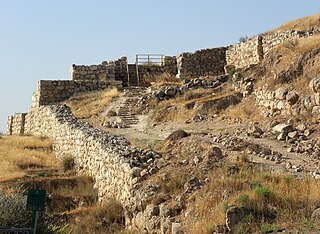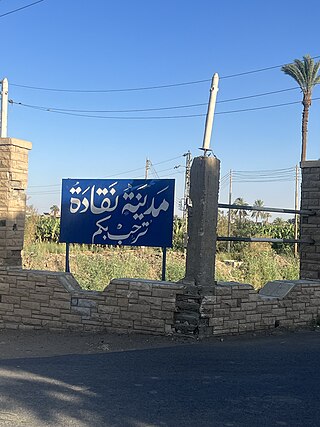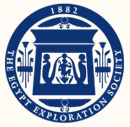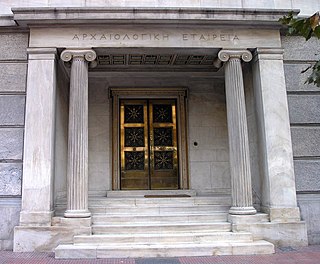Related Research Articles

Amarna is an extensive ancient Egyptian archaeological site containing the remains of what was the capital city during the late Eighteenth Dynasty. The city of Akhetaten was established in 1346 BC, built at the direction of the Pharaoh Akhenaten, and abandoned shortly after his death in 1332 BC. The name that the ancient Egyptians used for the city is transliterated as Akhetaten or Akhetaton, meaning "the horizon of the Aten".

Memphis, or Men-nefer, was the ancient capital of Inebu-hedj, the first nome of Lower Egypt that was known as mḥw ("North"). Its ruins are located in the vicinity of the present-day village of Mit Rahina, in markaz (county) Badrashin, Giza, Egypt.

Lachish was an ancient Canaanite and later Israelite city in the Shephelah region of Canaan on the south bank of the Lakhish River mentioned several times in the Hebrew Bible. The current tell by that name, known as Tel Lachish or Tell el-Duweir, has been identified with Lachish. Today, it is an Israeli national park operated and maintained by the Israel Nature and Parks Authority. It lies near the present-day moshav of Lakhish, which was named in honor of the ancient city.

Sir William Matthew Flinders Petrie, commonly known as simply Sir Flinders Petrie, was an English Egyptologist and a pioneer of systematic methodology in archaeology and the preservation of artefacts. He held the first chair of Egyptology in the United Kingdom, and excavated many of the most important archaeological sites in Egypt in conjunction with his wife, Hilda Urlin. Some consider his most famous discovery to be that of the Merneptah Stele, an opinion with which Petrie himself concurred. Undoubtedly at least as important is his 1905 discovery and correct identification of the character of the Proto-Sinaitic script, the ancestor of almost all alphabetic scripts.

Naqada is a town on the west bank of the Nile in Qena Governorate, Egypt, situated ca. 20 km north of Luxor. It includes the villages of Tukh, Khatara, Danfiq, and Zawayda. According to the 1960 census, it is one of the most uninhabited areas and had only 3,000 inhabitants, mostly of Christian faith who preserved elements of the Coptic language up until the 1930s.

The Egypt Exploration Society (EES) is a British non-profit organization. The society was founded in 1882 by Amelia Edwards and Reginald Stuart Poole in order to examine and excavate in the areas of Egypt and Sudan. The intent was to study and analyze the results of the excavations and publish the information for the scholarly world.

Gezer, or Tel Gezer, in Arabic: تل الجزر – Tell Jezar or Tell el-Jezari is an archaeological site in the foothills of the Judaean Mountains at the border of the Shfela region roughly midway between Jerusalem and Tel Aviv. It is now an Israeli national park. In the Hebrew Bible, Gezer is associated with Joshua and Solomon.
Archaeology is the study of human activity in the past, primarily through the recovery and analysis of the material culture and environmental data that they have left behind, which includes artifacts, architecture, biofacts and cultural landscapes.

Kazimierz Józef Marian Michałowski was a Polish archaeologist and Egyptologist, art historian, member of the Polish Academy of Sciences, professor ordinarius of the University of Warsaw as well as the founder of the Polish Centre of Mediterranean Archaeology. He coined the term "Nubiology" to refer to the study of ancient Nubia.
Below are notable events in archaeology that occurred in 1868.

The Archaeological Society of Athens is an independent learned society. Also termed the Greek Archaeological Society, it was founded in 1837 by Konstantinos Bellios, just a few years after the establishment of the modern Greek State, with the aim of encouraging archaeological excavations, maintenance, care and exhibition of antiquities in Greece.

John Garstang was a British archaeologist of the Ancient Near East, especially Egypt, Sudan, Anatolia and the southern Levant. He was the younger brother of Professor Walter Garstang, FRS, a marine biologist and zoologist. Garstang is considered a pioneer in the development of scientific practices in archaeology as he kept detailed records of his excavations with extensive photographic records, which was a comparatively rare practice in early 20th-century archaeology.

Christos Tsountas was a Greek classical archaeologist. He is considered a pioneer of Greek archaeology and has been called "the first and most eminent Greek prehistorian".
Below are notable events in archaeology that occurred in 1914.

Carthage National Museum is a national museum in Byrsa, Tunisia. Along with the Bardo National Museum, it is one of the two main local archaeological museums in the region. The edifice sits atop Byrsa Hill, in the heart of the city of Carthage. Founded in 1875 as the "Musée Saint-Louis" within the Chapelle Saint-Louis de Carthage in order to house the finds from the excavations of Alfred Louis Delattre, it contains many archaeological items from the Punic era and other periods.
The Deutsche Orient-Gesellschaft, abbreviated DOG, is a German voluntary association based in Berlin dedicated to the study of the Near East.
Jean Clédat was a French Egyptologist, archaeologist and philologist. He became a resident at the Institut Français d'Archéologie Orientale. At various times, Clédat's expeditions was sponsored by Compagnie universelle du canal maritime de Suez, the Supreme Council of Antiquities, the Comité, and the Institut itself.

Tell Nebesha or Nebesheh is an archaeological site in Egypt, and the location of the ancient city of Imet. It is found around 10km south of Tanis in the Eastern Nile Delta. This was the ancient capital of the 19th Nome of Lower Egypt. By the Assyrian period, it was succeeded by Tanis.
Saft el-Hinna, also written as Saft el-Hinneh, Saft el-Henna, Saft el-Henneh, is a village and an archaeological site in Egypt. It is located in the modern Al Sharqia Governorate, in the Nile Delta, about 7 km southeast of Zagazig.

The International Campaign to Save the Monuments of Nubia was the effort to relocate 22 monuments in Lower Nubia, in Southern Egypt and northern Sudan, between 1960 and 1980. This was done in order to make way for the building of the Aswan Dam, at the Nile's first cataract, a project launched following the 1952 Egyptian Revolution. This project was undertaken under UNESCO leadership and a coalition of fifty countries. This process led to the creation of the World Heritage Convention in 1972, and thus the system of UNESCO World Heritage Sites.
References
- ↑ "The scientific work". Archaeological Museum of Thebes . Retrieved 2017-11-23.
- ↑ Pourtaud, Jean-Sébastien; Olivet, Yves (2015). Dolmens, menhirs, tumulus et pierres de légendes de Charente-Maritime. Rioux-Martin: Le Croît Vif. p. 13. ISBN 9782361995294.
- ↑ Mylonas, George E. (1961). Eleusis and the Eleusinian Mysteries. p. 12-13.
- ↑ "Egypt Exploration Fund". British Museum. Retrieved 26 May 2017.